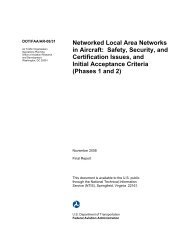Development of a Component Head Injury Criteria (HIC ... - FAA
Development of a Component Head Injury Criteria (HIC ... - FAA
Development of a Component Head Injury Criteria (HIC ... - FAA
Create successful ePaper yourself
Turn your PDF publications into a flip-book with our unique Google optimized e-Paper software.
In general, it appears that for simple geometries, such as panels, the NHCT device tends to<br />
produce results that are close but slightly greater than the results from FSSTs. Thus, <strong>HIC</strong> for the<br />
NHCT are conservative for the cases tested.<br />
The effects causing descrepancies can be categorized into the following groups:<br />
• Variations in the behavior <strong>of</strong> the test articles. These variations, such as unpredictable<br />
inertia-induced flexing <strong>of</strong> tall divider panels or different failure modes <strong>of</strong> tray tables, are<br />
unavoidable and difficult to correct.<br />
• Variations caused by kinematic approximations in the NHCT. While the NHCT<br />
approximates a kinematic copy <strong>of</strong> the 50 th percentile male Hybrid II ATD as closely as<br />
possible, some differences are present, such as lack <strong>of</strong> a flexible neck, incompressible<br />
spine, and a different lower torso friction properties. Simulations have shown that while<br />
the contribution <strong>of</strong> a flexible neck to the <strong>HIC</strong> may not be a substantial contributing factor<br />
in causing <strong>HIC</strong> values to vary from FSST values for simple target geometries, it could<br />
have a more pronounced effect for more complex targets, such as seat backs with tray<br />
tables. Designs for rectifying these limitations are available and can be implemented<br />
with relative ease.<br />
• Variations in FSST-NHCT test conditions. As noted previously, <strong>HIC</strong> in general is<br />
extremely sensitive to test parameters, i.e., impact velocity and impact angle. This being<br />
the case, one would expect that validation <strong>of</strong> the NHCT would be difficult using a one-toone<br />
comparison <strong>of</strong> the FSST and NHCT test data.<br />
11. REFERENCES.<br />
1. Chandler, R.F., “Human <strong>Injury</strong> <strong>Criteria</strong> Relative to Civil Aircraft Seat and Restraint<br />
Systems,” SAE Paper 851847, Society <strong>of</strong> Automotive Engineers, Warrendale, PA, 1985.<br />
2. Lissner, H.R., Lebow, M., and Evans, F.G., “Experimental Studies on the Relation<br />
Between Acceleration and Intracranial Pressure Changes in Man,” Surgery, Gynecology,<br />
and Obstetrics, V. 111, 1960, pp 329-338.<br />
3. Gadd, C.W., “Use <strong>of</strong> a Weighted Impulse Criterion for Estimating <strong>Injury</strong> Hazard,” SAE<br />
Paper 660793, Proceedings <strong>of</strong> the Tenth Stapp Car Crash Conference, Society <strong>of</strong><br />
Automotive Engineers, Warrendale, Pennsylvania, 1966, pp. 16-174.<br />
4. Versace, J., “A Review <strong>of</strong> the Severity Index,” SAE Paper 710881, Proceedings <strong>of</strong> the<br />
Fifteenth Stapp Car Crash Conference, Society <strong>of</strong> Automotive Engineers, Warrendale,<br />
Pennsylvania, 1971, pp. 771-796.<br />
5. Gurdjian, E.S., Lissner, H.R., Latimer, F.R., Haddad, B.F., and Webster, J.E.,<br />
“Quantitative Determination <strong>of</strong> Acceleration and Intercranial Pressure in Experimental<br />
<strong>Head</strong> <strong>Injury</strong>,” Neurology 3,4, 1953, pp. 4223.<br />
42

















